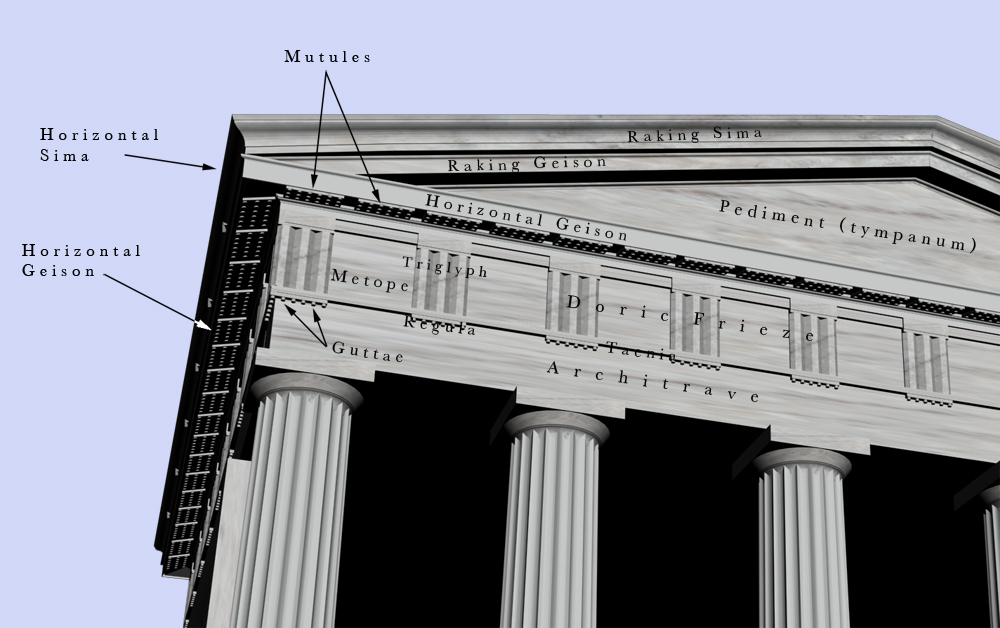Guttae on:
[Wikipedia]
[Google]
[Amazon]
 A gutta (
A gutta (
File:Metope - Temple of Poseidon - Paestum - Italy 2015 (2).JPG, So-called "Temple of Poseidon", Paestum, Italy.
File:RomanDoricOrderEngraving.jpg, Theater of Marcellus: cone-shaped guttae pictured below the triglyph in the
 A gutta (
A gutta (Latin
Latin (, or , ) is a classical language belonging to the Italic branch of the Indo-European languages. Latin was originally a dialect spoken in the lower Tiber area (then known as Latium) around present-day Rome, but through the power ...
pl. guttae, "drops") is a small water-repelling, cone-shaped projection used near the top of the architrave of the Doric order
The Doric order was one of the three orders of ancient Greek and later Roman architecture; the other two canonical orders were the Ionic and the Corinthian. The Doric is most easily recognized by the simple circular capitals at the top of ...
in classical architecture
Classical architecture usually denotes architecture which is more or less consciously derived from the principles of Greek and Roman architecture of classical antiquity, or sometimes even more specifically, from the works of the Roman architect ...
. At the top of the architrave blocks, a row of six ''guttae'' below the narrow projection of the taenia (fillet) formed an element called a regula. A ''regula'' was aligned under each triglyph of the Doric frieze. In addition, the underside of the projecting geison above the frieze had rectangular protrusions termed '' mutules'' that each had three rows of six ''guttae''. These mutules were aligned above each triglyph and each metope.
It is thought that the guttae were a skeuomorphic representation of the pegs used in the construction of the wooden structures that preceded the familiar Greek architecture in stone. However, they have some functionality, as water drips over the edges, away from the edge of the building.
Outside the Doric
In the strict tradition of classical architecture, a set of guttae always go with a triglyph above (and vice versa), and the pair of features are only found in entablatures using the Doric order. In Renaissance and later architecture these strict conventions are sometimes abandoned, and guttae and triglyphs, alone or together, may be used somewhat randomly as ornaments. The Doric order of the Villa Lante al Gianicolo in Rome, an early work of Giulio Romano (1520–21), has a narrow "simplified entablature" with guttae but no tryglyphs. The stone fireplace in theOval Office
The Oval Office is the formal working space of the President of the United States. Part of the Executive Office of the President of the United States, it is located in the West Wing of the White House, in Washington, D.C.
The oval-shaped ro ...
has Ionic columns at the side, but the decorative wreath in the centre of the lintel
A lintel or lintol is a type of beam (a horizontal structural element) that spans openings such as portals, doors, windows and fireplaces. It can be a decorative architectural element, or a combined ornamented structural item. In the case o ...
has sets of guttae below (only five to a set).See gallery The Baroque ÄŚernĂn Palace in Prague
Prague ( ; cs, Praha ; german: Prag, ; la, Praga) is the capital and largest city in the Czech Republic, and the historical capital of Bohemia. On the Vltava river, Prague is home to about 1.3 million people. The city has a temperate ...
(1660s) has triglyphs and guttae as ornaments at the top of arches, in a facade using an eclectic Ionic order.
Gallery
Doric order
The Doric order was one of the three orders of ancient Greek and later Roman architecture; the other two canonical orders were the Ionic and the Corinthian. The Doric is most easily recognized by the simple circular capitals at the top of ...
.
File:Villa Lante al Gianicolo.jpg, Villa Lante al Gianicolo, guttae but no triglphs. Giulio Romano, 1520–21.
File:Praha, HradÄŤany, ÄŚernĂnskĂ˝ palác, fasáda 01.jpg, ÄŚernĂn Palace in Prague
Prague ( ; cs, Praha ; german: Prag, ; la, Praga) is the capital and largest city in the Czech Republic, and the historical capital of Bohemia. On the Vltava river, Prague is home to about 1.3 million people. The city has a temperate ...
(1660s) has triglyphs and guttae as ornaments at the top of arches.
File:Detall de la portada de Sant Pius V, València.JPG, Dentils, triglyphs, and guttae, Museu de Belles Arts de València.
File:CLOSE- UP OF TRIGLYPHS, ALSO PILASTER CAP ON S. W. CORNER OF BUILDING - Christ Episcopal Church, Church and Saint HABS ALA,49-MOBI,33-10.tif, Triglyphs and pilaster
In classical architecture, a pilaster is an architectural element used to give the appearance of a supporting column and to articulate an extent of wall, with only an ornamental function. It consists of a flat surface raised from the main wal ...
cap, Christ Episcopal Church, Mobile, Alabama.
File:Ambassador Rick Olson with President Barack Obama.jpg, US Ambassador Rick Olson with President Barack Obama, in the Oval office
The Oval Office is the formal working space of the President of the United States. Part of the Executive Office of the President of the United States, it is located in the West Wing of the White House, in Washington, D.C.
The oval-shaped ro ...
, with guttae on the Ionic fireplace.
Notes
References
*Summerson, John
Sir John Newenham Summerson (25 November 1904 – 10 November 1992) was one of the leading British architectural historians of the 20th century.
Early life
John Summerson was born at Barnstead, Coniscliffe Road, Darlington. His grandfather wo ...
, '' The Classical Language of Architecture'', 1980 edition, Thames and Hudson ''World of Art'' series, {{ISBN, 0500201773
Architectural elements
Columns and entablature